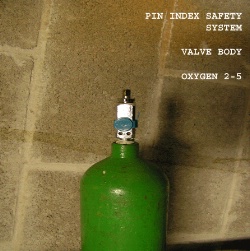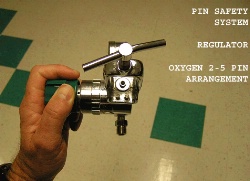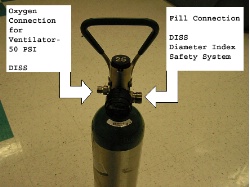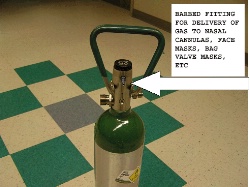Oxygen Connection Safety Systems
Bill Gearhart, CHT, DMT, EMT, CFPS
UHMS Safety Committee
In the last edition of Pressure, I wrote an article explaining the storage details of small, "E” sized oxygen cylinders in the Health Care Environment.
I received one question regarding the article and it asked if there could be more cylinders if the area was larger. The determining factor in this situation is the smoke compartment size requirement in a Health Care Occupancy, which is limited to 22,500 square feet, (2,100 meters square) and the travel distance to an exit can be no longer than 200 linear feet. These requirements are stated in NFPA 101, 18.3.7 & 19.3.7, (Subdivision of Building Spaces), New and Existing Health CareOccupancies, respectively.
 Therefore, the area cannot be larger than 22,500 sq ft and that is the controlling factor. Also, the limit of cylinders applies to both full and partially full cylinders since partially full cylinders are considered full for this purpose.
Therefore, the area cannot be larger than 22,500 sq ft and that is the controlling factor. Also, the limit of cylinders applies to both full and partially full cylinders since partially full cylinders are considered full for this purpose.
The topic for this issue pertains to safety devices which are industry standards regarding the various connecting systems for oxygen and other gas cylinders and equipment.
A medical gas is defined as one that is manufactured, packaged, and intended for administration to a patient in anesthesia, therapy, or diagnosis. Title 21 of the code of Federal Regulations, (CFR) designates medical gases as drugs, and mandates the Secretary of the Treasury and the Secretary of Health and Human Services to promulgate regulations for the efficient enforcement of the Federal Food, Drug, and Cosmetic Act, (FDA) (drug portion of 21 CFR).
Other regulatory agencies involved in regulation and standards for oxygen gas storage, delivery and use include; Department of Transportation (DOT) Compressed Gas Association (CGA) and the National Fire Protection Association (NFPA). Regulations regarding the purity of these substances are established by the United States Pharmacopeia/National Formulary (USP/NF).
Medical gases are the most frequently administered drugs in the United States and therefore, as practitioners and technologists in hyperbaric medicine, we should have a good working knowledge regarding their safe and effective storage and delivery.
 One of the most obvious safety devices with regard to gas cylinders is the requirement for color coding. Although there may be some variation, a good reference source can be found in NFPA 99C, Table 4-5.1.2.12. or NFPA 99, Table 5.1.11. (Same table different reference site)
One of the most obvious safety devices with regard to gas cylinders is the requirement for color coding. Although there may be some variation, a good reference source can be found in NFPA 99C, Table 4-5.1.2.12. or NFPA 99, Table 5.1.11. (Same table different reference site)
There are several safety systems for connectors that are used in connecting gas cylinders to delivery devices. Each system provides a level of safety designed to prevent improper connection of gas sources and devices based on pressure and type of gas.
When working with high pressure cylinders, the American Standard Safety System, (ASSS) utilizes threaded high pressure connections. There are approximately 60 recognized gases and gas mixtures and 26 different connection; therefore, each gas or gas mixture may not have it's own unique connection.
These connections have a stamped code. For example:
(CGA-540 0.903-14 NGO-RH-EXT)
This code would be interpreted as:
CGA = Compressed Gas Association – Connection No. 540
Outlet Thread Diameter of 0.903 with 14 threads per inch
The threads are Right Hand and are External
 Another system designed to provide a level of safety is the Pin Index Safety System, (PISS). If you have handled anesthesia gas, you are familiar with this system. The system utilizes a system of 6 pins, (on regulators) and 6 holes (on valve bodies) which will only accept the two components when they are compatible.
Another system designed to provide a level of safety is the Pin Index Safety System, (PISS). If you have handled anesthesia gas, you are familiar with this system. The system utilizes a system of 6 pins, (on regulators) and 6 holes (on valve bodies) which will only accept the two components when they are compatible.
The gas which we use most often is oxygen, and the pin index arrangement for oxygen delivery is recognized as the 2-5 arrangement.
A third safety system employing different diameter and thread counts is the Diameter Safety System, (DISS). The aforementioned ASSS and PISS safety systems are designed for high pressure, (exceeding 200 PSI) while the DISS is for low pressure cylinders and equipment, (less than 200 PSI).
These connections are generally located downstream of pressure reducing valves attached to supply cylinders or systems, at wall outlets of central piping systems and at the inlet of flow meters, nebulizers, ventilators and other gas/air delivery apparatus.
A hand tightened nut, (sometimes employing a knurled hand wheel) is used to fasten the threaded male/female connection. The union is achieved when the matching shoulders of the nipple and the bores of the valve body and regulator or matching connectors mate.
Safety Indexing is achieved by varying the dimensions of the borings and shoulders of the joining connections. There are 11 indexed DISS connections plus one for oxygen for a total of 12 different connections. The oxygen connection, designated #1240, has a threaded connector 0.5625 inches in diameter and 18 threads per inch. Color coding can also been integrated into the DISS system with air and oxygen lines being color coded yellow and green, respectively.
This arrangement is often seen with respiratory ventilators connected to either wall outlets or "E” cylinders when used in patient transport.
 Finally, a system of "QD” Quick Connect-Quick Disconnect is available and the variations are based on applications similar to the DISS system. These connections are designed for specific gases. However, one unfortunate problem with "QD” connections is they are manufacturer specific and not industry standard. Therefore, all the connections must be of a single manufacturer to guarantee compatibility.
Finally, a system of "QD” Quick Connect-Quick Disconnect is available and the variations are based on applications similar to the DISS system. These connections are designed for specific gases. However, one unfortunate problem with "QD” connections is they are manufacturer specific and not industry standard. Therefore, all the connections must be of a single manufacturer to guarantee compatibility.
In summation, there are several safety systems in use for the delivery of medical gases in the Health Care Industry. While these systems help to eliminate problems and errors in medical gas delivery; ultimately, the responsibility rests with the individual provider. The health care provider should utilize a designed system for delivery of the proper medical gas, at the prescribed delivery rate as per the medical directive.
Obviously, there is much more information available regarding these safety systems. The internet provides many sources and links for regulatory agencies and articles further describing gas delivery safety systems.
